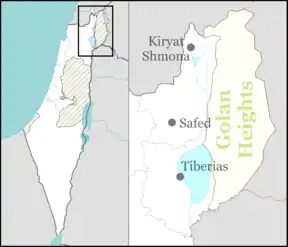Ma'ayan Baruch
Ma'ayan Baruch (Hebrew: מַעְיַן בָּרוּךְ, lit. 'Blessed Spring') is a kibbutz in northern Israel. Located near the Lebanese border, it falls under the jurisdiction of Upper Galilee Regional Council. In 2014 it had a population of 720.[1]
Ma'ayan Baruch | |
|---|---|
 Ma'ayan Baruch  Ma'ayan Baruch | |
| Coordinates: 33°14′28″N 35°36′32″E | |
| Country | |
| District | Northern |
| Council | Upper Galilee |
| Affiliation | Kibbutz Movement |
| Founded | 11 March 1947 |
| Population (2021) | 723[1] |

History
The kibbutz was founded on 11 March 1947,[2] on the land of Hamara, a moshav abandoned in 1920. The founders were members of other kvutzot who had met in Kfar Giladi; members of the HaTenua HaMeuhedet youth movement, members of Habonim who immigrated to British Mandate of Palestine as Ma'apilim (illegal immigrants of Aliyah Bet), and members of a garin of pioneering soldiers from South Africa who fought in the British Army during World War II.[2]
After the 1948 Palestine war, Ma'ayan Baruch took over part of the land belonging to the newly depopulated Palestinian village of al-Sanbariyya.[3]
During the 2023 conflict between Hamas and Israel, northern Israeli border communities, including Ma'ayan Baruch, faced targeted attacks by Hezbollah and Palestinian factions based in Lebanon, and were evacuated.[4]
Development projects
A new neighborhood in Ma'ayan Baruch was built to attract newcomers and bring money into the kibbutz coffers in the wake of the socio-economic problems that have affected many kibbutzim since the 1980s. The newcomers are from other kibbutzim and townships in the region, as well as other parts of the country.[5]
Landmarks
A museum which holds a collection of prehistoric artifacts found in the Hula Valley, The Prehistoric Man Museum, is located on the kibbutz. The museum collection includes the skeleton of a prehistoric woman, approximately 50 years old, buried with her dog.[6][7]
 Ma’ayan Baruch 11 March 1947
Ma’ayan Baruch 11 March 1947 Day of Aliyah - Ma'ayan Baruch 1947. The 3 Palestine Policemen include Amnon Assaf, founder of the Upper Galilee Prehistoric Museum[8]
Day of Aliyah - Ma'ayan Baruch 1947. The 3 Palestine Policemen include Amnon Assaf, founder of the Upper Galilee Prehistoric Museum[8] Ma'ayan Baruch. First buildings 1947
Ma'ayan Baruch. First buildings 1947 Ma’ayan Baruch 1947
Ma’ayan Baruch 1947
Notable people
- Menashe Kadishman (born 1932), sculptor and painter
- Rela Mazali (born 1948), Israeli peace activist and writer
- Amnon Shamosh, Israeli author and poet
See also
- Notes from the Frontier, an account of life on the kibbutz in the mid-1960s by American author Hugh Nissenson.
References
- "Regional Statistics". Israel Central Bureau of Statistics. Retrieved 22 February 2023.
- "Une nouvelle colonie en Haute-Galilee". Hehaloutz. 1 June 1947.
- Khalidi, Walid (1992). All That Remains:The Palestinian Villages Occupied and Depopulated by Israel in 1948. Washington D.C.: Institute for Palestine Studies. p. 494. ISBN 0-88728-224-5.
- Fabian, Emanuel. "IDF to evacuate civilians from 28 communities along Lebanese border amid attacks". www.timesofisrael.com. Retrieved 2023-10-22.
- Depression in Margaliot, Hope in Maayan Baruch Haaretz, 11 July 2008
- James Serpell, The domestic dog: its evolution, behaviour, and interactions with people, pp 10-12. Cambridge University Press, 1995.
- SJM Davis and FR Valla, Evidence for domestication of the dog 12,000 years ago in the Natufian of Israel, Nature 276, 608-610 (7 December 1978)
- "Founder Biography | english". www.ugmp.co.il. Archived from the original on 2014-04-14.